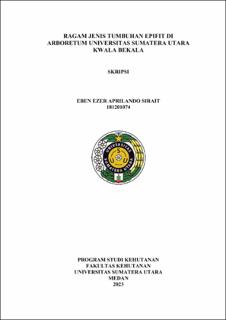Ragam Jenis Tumbuhan Epifit di Arboretum Universitas Sumatera Utara Kwala Bekala
Various Types of Epiphytic Plants in the Arboretum of the Universitas Sumatera Utara Kwala Bekala

Date
2023Author
Sirait, Eben Ezer Aprilando
Advisor(s)
Susilowati, Arida
Elfiati, Deni
Metadata
Show full item recordAbstract
Epiphytic plants are plants that attach and grow on other plants to obtain sunlight,
water, and absorb nutrients from the host tree's skin surface. The identification of epiphytes
in various land covers needs to be carried out as a reference in determining appropriate
epiphyte conservation efforts in the future, one of which needs to be done in the Arboretum
USU. This research aims to identify the types of epiphytes, analyze their distribution
patterns and density, as well as identify the types of host trees that are inhabited by
epiphytes and the correlation between them. The data sources for this study are primary
and secondary data, and the research method used is census method. The data obtained is
analyzed using vegetation analysis and correlation analysis. The results show that there
are 17 types of epiphytes from seven families with a total of 14.012 individuals. Pyrrosia
piloselloides is the largest species with a total of 5549 individuals (39.60%). Meanwhile,
Cymbidium finlasonianum is the species with the fewest individuals, only 6 (0.04%). The
highest INP was found in Pyrrosia piloselloides at 45.48%. There are 38 types of trees that
serve as hosts for epiphytes, and the Alstonia scholaris tree species is the most commonly
inhabited host with a total of 4.212 individuals. The correlation analysis shows that two
out of five parameters have negative values (bark thickness and branch angle), and three
parameters have positive values (tree height, trunk diameter, and number of branches). All
epiphyte species found have the potential for use as ornamental plants and medicinal herbs.
The threat level for all epiphyte species in the USU Arboretum is currently unknown since
they have not been listed on the IUCN Red List. This research also indicates that no
invasive epiphyte species were found in the USU Arboretum.
Collections
- Undergraduate Theses [1996]
